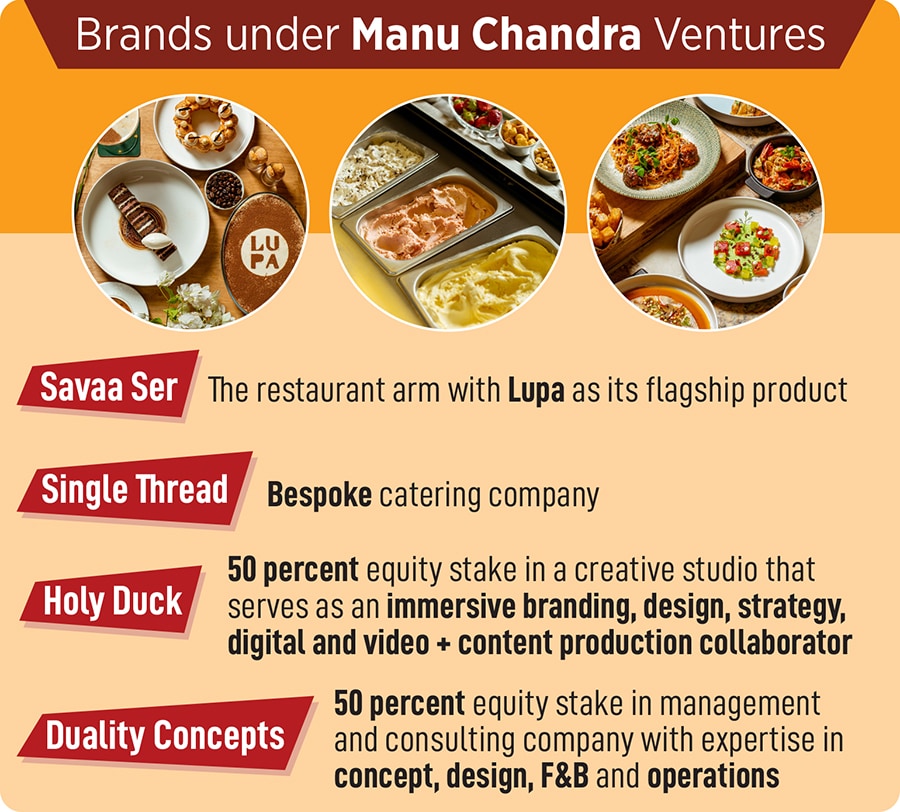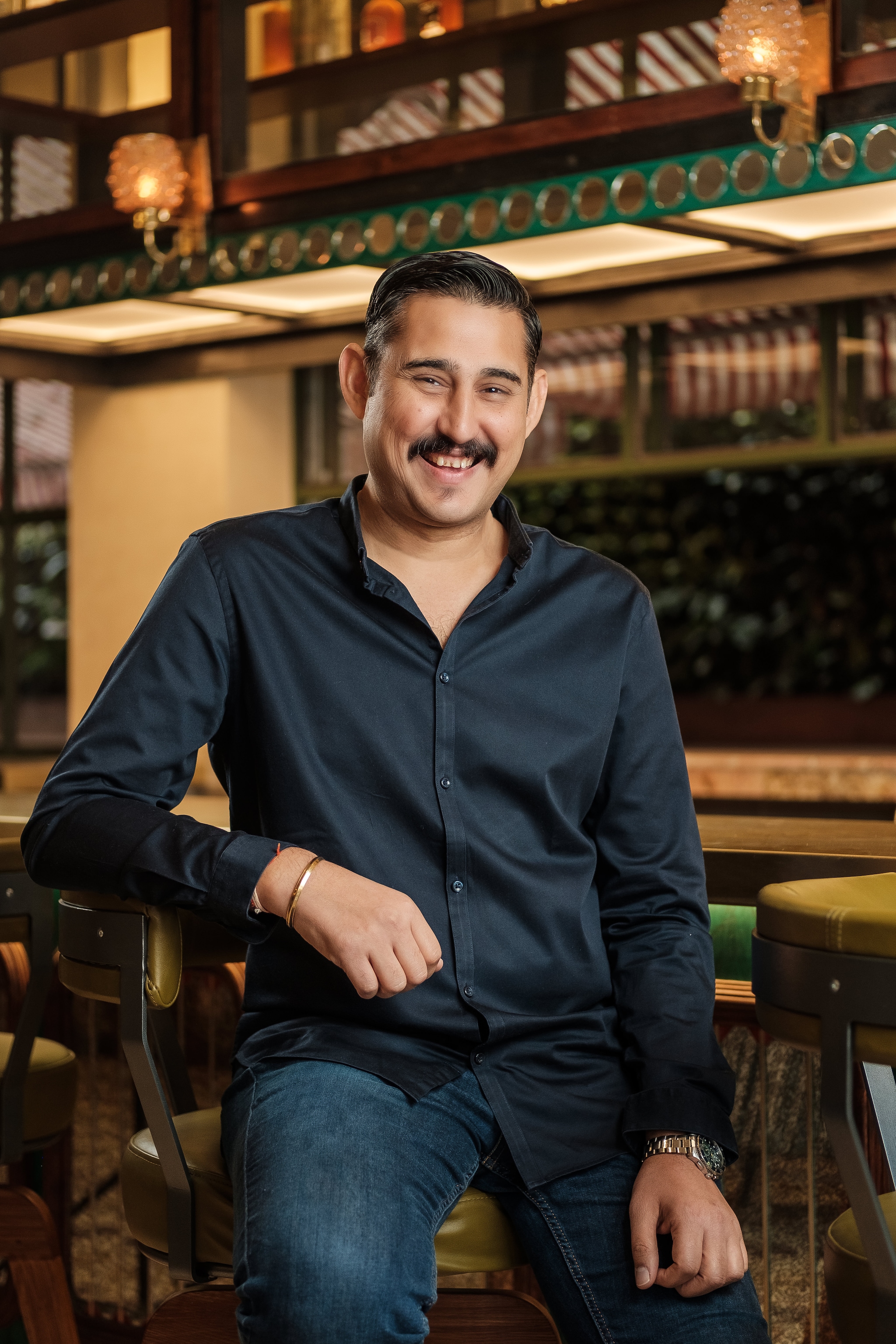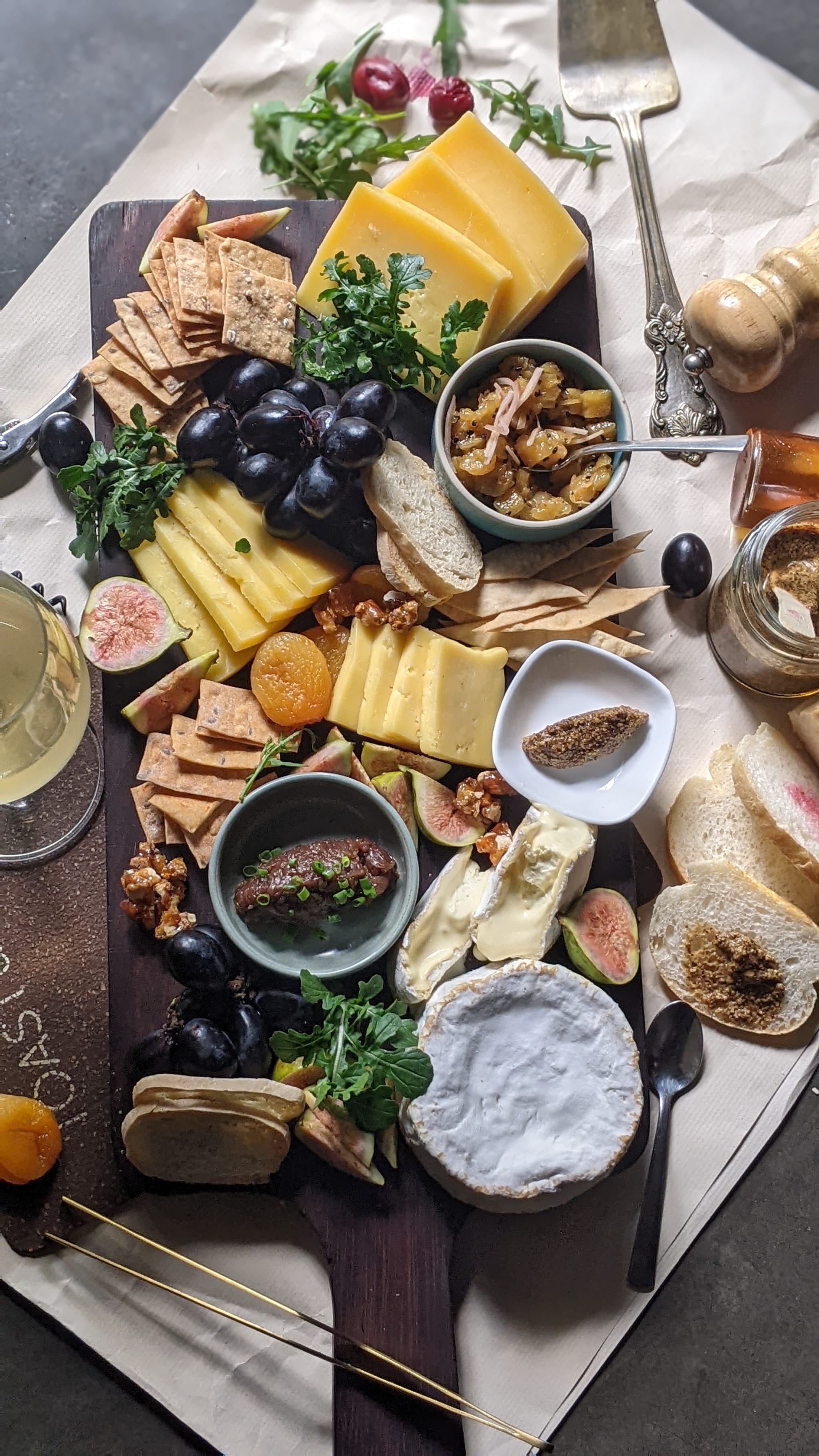What's cooking with Manu Chandra?
In 2021, in the middle of Covid, the chef had left the Olive group, his workplace of 17 years, to start his own company. How is he looking to navigate the treacherous F&B ecosystem and build up a sust


One morning in January, Manu Chandra returned to Bengaluru post a “ridiculously long flight with a prolonged layover in Mumbai", dropped his bags at home and set out for work almost immediately, where he spent the day to “clear up a bunch of pending stuff". Once done, the chef-turned-entrepreneur headed straight to a premium event that was being serviced by his fledgling bespoke catering company, Single Thread, and jumped on to the line to fix a few items that weren’t perfect. “This, after I had just returned from five straight days of cooking at the World Economic Forum (WEF) in Davos. The two other chefs who had travelled with me had landed and passed out for the next eight hours due to exhaustion," says Chandra, whom we meet the next morning at his 220-cover restaurant Lupa (meaning she-wolf in Italian) that, back then, was still receiving the finishing touches before launch. “My sister tells me I am crazy."
Many would have concurred with her when Chandra, a chef-partner at the Olive Group, quit his workplace of 17 years in September 2021, to pile an entrepreneur’s hat above his toque. At a time the Covid-19 pandemic, which upended the F&B industry, was still far from over, Chandra launched Manu Chandra Ventures (MCV) along with Chetan Rampal, colleague, friend and fellow hospitality fiend. Single Thread was their maiden offering through which MCV landed marquee gigs like the WEF and the 2022 Cannes Film Festival and with top corporates like Spotify, serendipitously bringing it much-needed publicity and buzz. Lupa, the company’s flagship brand, opened its doors in February, inhabiting 11,000 square feet on Bengaluru’s arterial MG Road and housing, among other things, Tuscan-themed interiors, a marble fountain, a salumeria and a gelateria.
“The pandemic was a huge wake-up call and showed me the fragility of the hospitality sector. I wanted to do something a little more diverse and sustainable than just restaurants," says Chandra. “Also, this was the last shot at doing something for myself. If I continued at perpetuity for another 10-15 years, I’d become too comfortable and risk averse."
The holding company of MCV has in its ambit four verticals: Single Thread, its restaurant arm Savaa Ser, while it has made strategic investments into Holy Duck, a creative studio for branding collaborations, and Duality Concepts, a turnkey management and consulting company. The last two are expected to help Chandra build brands and their visibility in quick time, eliminating loops of back and forth. “One of the biggest pain points of setting up brands and rolling them out is that you get stuck with these, especially in this day and age when social media plays a big role. You need to be on top of activations and what you are putting out. With these companies, I have equity in the entire supply chain," says Chandra of the companies in which MCV is a 50 percent equity shareholder.
The initial corpus to launch MCV with Single Thread and Lupa has totalled to somewhere between Rs10 crore and Rs15 crore, and have come from personal savings, soft loans from friends and family, and some debt. “I haven’t gone to any institutional investors or PE funds. MCV owns 100 percent equity in the company of which I own a majority stake," says Chandra.
He adds: “A lot of private investors have reached out to me, and I am tempted occasionally. But I am not looking to do any stake dilutions right now. Is it wise from a larger valuation standpoint? Maybe not. But I want to set up a portfolio of brands first before I go look for external funding."

Building brands is something that Chandra has been a champion of. In his previous stint with Olive, he brought to India the concept of gastropubs, marrying the existing standalone categories of a watering hole and an eatery. Monkey Bar and the Fatty Bao were considered trendsetters in the dining space. Alongside, Chandra also launched successful brands like Toast & Tonic and Cantan.
But with Lupa, he says, he is taking a step back from introducing dining styles and going back to the basics. “There is a seafood platter, I have a great pizza oven that will churn out Neapolitan pizza without having to worry about wood fire, there is a good pasta programme, a good dessert programme, there’ll be tableside action, like we’ll assemble the beef tartare next to you at the table," he says. Yet, despite covering a whole spectrum of crowd favourites, Chandra won’t call this a multicuisine restaurant, but a Western restaurant with enough play to accommodate influences. “Will we make kung pao chicken here? No. But will you get a chicken with a hint of lemongrass because that"s adding to the flavour profile? That"s a possibility."
Lupa gives Chandra the opportunity to vertically integrate his personal investments into the company—the chef is the founder-partner at the Bengaluru-based artisanal cheese brand Begum Victoria, a product showcased through his menu at the salumeria as well as the gelataria. He is also a strategic investor in plant protein brand Shaka Harry and Chota Hazari Spirits, a company focussed on small-batch liquors, one of which is expected to hit the shelves by the end of the year.
With Lupa and Single Thread, Chandra, in some sense, is traversing a path reverse to what he did at the Olive Group, where he had established casual brands with a mass market appeal and affordability. With APCs (average per cover) around Rs1,200-1,500, the Monkey Bars and Fatty Baos were a draw for the expanding bracket of upwardly mobile, aspirational diners without being prohibitively expensive.
Lupa, on the other hand, holds a premium position at an APC of Rs3,000 plus taxes, at a time the world of F&B is dabbling with the possible death of fine-dining, spurred by the announcement that Rene Redzepi’s Noma, the Copenhagen restaurant considered to be among the world’s best, will be shutting operations in 2024 and pivoting to a food lab. Not just Noma, but fine-dining restaurants the world over have struggled to build sustainable businesses given the razor-thin margins they operate on.
In India, too, says Ankur Bisen, senior partner and head, consumer, food and retail, at consulting firm Technopak, it’s a two-and-a-half city play—Mumbai, Delhi and part-Bengaluru—and sustainable fine-dining seems to be like an oxymoron. “Fine-dining has returned and grown post Covid, but have we really seen any fine-dining restaurant grow to scale?" he asks. The size of the market is around Rs3,000-4,000 crore, and, while it is growing at 15 percent year-on-year, the large percentage projection is abetted by a small base.
In such a challenging climate for fine-dining, what gives Chandra the confidence that he won’t fold up under the pressures of the bottomline? “Because Lupa has learnt from the mistakes of Noma," he says.
“It’s ridiculous," he adds, “how many people it requires to make one plate of food at Noma, creating such elevated experiences that you can handle only 30 people a day. This is a scale game. At Lupa, I have 220 covers and I need to fill them, and bring these customers back. I am setting up loyalties here, not unique experiences that you will only want to come to only once, and it is only through loyalties that you build a sustainable restaurant model."
Chandra says he had dined at Noma once and, while the food was “exceptional", he wouldn’t go back in a hurry. “Am I taking away from Noma what they did in terms of food? No," he says. “The food was more intellectual than emotional. It’s precisely the sort of thing that doesn’t work in an Indian context, so I aim to work from the basics up. The Noma strategy is next to impossible to pull off sustainably in India, yet."
 Chetan Rampal_Founder-Partner, Manu Chandra VenturesImage: Nishant Ratnakar for Forbes India
Chetan Rampal_Founder-Partner, Manu Chandra VenturesImage: Nishant Ratnakar for Forbes India
In four months of its operations, he claims, Lupa has turned operationally profitable, while Single Thread, which had its first event in March 2022, and has already catered to over 100, is a self-contained business even though it’s yet to make profits.
His conviction to pull off a fine-dining restaurant could be construed as cocky, but that’s how Ritu Dalmia, chef and restaurateur and owner of Diva, the celebrated Italian restaurant, remembers Chandra and that’s what she marked out as his USP when he came to interview with her fresh out of the Culinary Institute of America (CIA) nearly 20 years ago. “He was smart and cocky. I liked his cockiness because I could be on the same wavelength with him. He knew his products at a time when no one knew what a gorgonzola was," says Dalmia.
“I was very impressed with him and asked him to open something of his own. He took my advice late but, as they say, better late than never," she adds with a laugh. “As a chef, he is curious and experimental and, at the same time, clever enough to know what people want, so he doesn’t go too crazy."

Chandra says he doesn’t want a restaurant with all aspirational dishes. “There needs to be an intelligent straddling of aspirational and comfort food," he says. That’s why he has instituted multiple touchpoints at Lupa to have his customers return again and again. And, while within his portfolio, Lupa qualifies as the premium, aspirational product, he and Rampal are looking at another multi-brand play that will have more “easy products"—easy to execute, easy to scale and cater to a wider audience—which would also be the levers of growth.
“Will Lupa grow into three-four-five outlets? I don’t think so. We are working on creating four or five ‘easy’ brands—Italian, Asian, a bar product, among others. If all goes well, by the end of this year, we should have opened up a couple of them," says Rampal.
MCV’s second business vertical, Single Thread, has latched on to an emerging trend post Covid, where restaurants have branched out into premium, private catering. “It’s a scattered market, so it’s difficult to assess the size," says Bisen of Technopak, “but it’s become the new, niche market."
Chandra says it was the “low-hanging fruit" when he started, as it had an asset-light model and a faster time-to-market. But it’s also a sector that calls for focus and clear definition of your work profile, says Varun Tuli, founder and the managing director of the Yum Yum Tree Group, which runs restaurants like Yum Yum Cha and catering business Food Inc. “Today, we work all over the world, but when we started we were primarily restricted to a Delhi-based audience. Slowly, we grew that to a Marwari audience. Then we went to Rajasthan, then south India, and then outside the country. You build up slowly. The idea is to not spread yourself too thin," says Tuli.
High-end catering can also be daunting, given the scale and the effort involved to personalise experiences for, say, 500 premium guests. Insiders in the F&B industry say the APC for premium private catering could range anywhere between Rs2,500 and Rs10,000 depending on the level of customisation. Says Tuli, among the restaurateurs to have handled both dining and catering as well as cloud kitchens, “If you are running multiple verticals, you have to understand what your role is and then have professionals manage them. My role is creative and I strictly don’t go beyond that, into categories like finance or ops."
 Lupa gives Chandra the opportunity to vertically integrate his personal investments into the company—the chef is the founder-partner at the Bengaluru-based artisanal cheese brand Begum Victoria, a product showcased through his menu at the salumeria as well as the gelataria
Lupa gives Chandra the opportunity to vertically integrate his personal investments into the company—the chef is the founder-partner at the Bengaluru-based artisanal cheese brand Begum Victoria, a product showcased through his menu at the salumeria as well as the gelataria
Rampal, who has worked with Chandra since his Olive days, is the perfect foil to him in MCV looking after operations while Chandra unleashes his creativity in the kitchen. They don’t have defined lines on sharing responsibilities, says Rampal, but both know when not to overstep and also what to make of the said and unsaid. “Every morning Manu comes up with 20 ideas, many of which won’t work at this point of time. The beauty of it is that not only do I know that, he knows that too and neither of us needs to spell it out and waste our time," he says. “I work with his pros and cons, and he with mine. That’s how the partnership has blossomed."
Chandra, known to be a man of few words, wry humour and camera-shyness—“If you want to poke fun at him, ask him to pose with selfie-seekers," reveals Rampal—is also learning to let go of his penchant for micro-management, he admits. “It has been my biggest learning or unlearning, whatever you want to call it," he says.

“Learning is a good word over there," Rampal laughs. “But, on a serious note, Manu is a guy who loves to be hands-on. He leads a team by example, so you’ll often see him in the kitchen cooking food." He’s also a self-motivated chef and sets a similar benchmark for his team, adds Rampal. “If you want a pat on your back or a ‘well done’ every second day, that isn’t gonna happen with him. Do these make him a difficult person? No. He is just a thorough professional."
Where do Chandra and Rampal want to take this company in the next five years? Scale through a multi-brand portfolio, of course, but they insist they haven’t set themselves a number to chase. “We don’t have a five-year or a 10-year plan. We don’t have a calendar that beeps often to tell us we are lagging on our timetable to open another restaurant," says Rampal. “All we want to do is grow in a healthy work environment."
First Published: Jun 14, 2023, 11:14
Subscribe Now